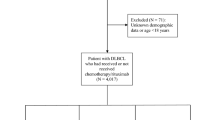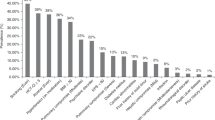Abstract
Socioeconomic status (SES) is an important determinant of disparities in health care. The association of SES with outcomes in autologous hematopoietic cell transplantation (AHCT) has not been described previously. We conducted a retrospective cohort study of 687 AHCT recipients with lymphoma transplanted between 2003 and 2013. Patients were categorized into low (<$50 000/year) and high SES (⩾$50 000/year). A greater proportion of low SES patients lived farther away from our center (median 54 vs 28 miles), belonged to a racial minority (12 vs 3%), had poorer performance status (4 vs 1%) and had high-risk disease at AHCT (9 vs 5%). Median follow-up was 53 months. In univariable analysis, low SES patients had significantly higher relapse mortality and lower OS and PFS. This was confirmed on multivariable analysis for relapse mortality (HR for high vs low SES: 0.74 (95% confidence interval (CI), 0.54–0.99), P=0.05), OS (HR 0.74 (0.58–0.95), P=0.02) and PFS (HR 0.77 (0.63–0.95), P=0.02). In multivariable analysis of ⩾1-year progression-free survivors, high SES patients had better OS (HR 0.73, P=0.05 vs low SES) that was primarily driven by a trend toward lower risk of non-relapse mortality (HR 0.62, P=0.06). SES is associated with outcomes of AHCT in patients with lymphoma.
This is a preview of subscription content, access via your institution
Access options
Subscribe to this journal
Receive 12 print issues and online access
$259.00 per year
only $21.58 per issue
Buy this article
- Purchase on Springer Link
- Instant access to full article PDF
Prices may be subject to local taxes which are calculated during checkout


Similar content being viewed by others
References
Olszewski AJ, Shrestha R, Cook NM . Race-specific features and outcomes of nodular lymphocyte-predominant Hodgkin lymphoma: analysis of the National Cancer Data Base. Cancer 2015; 121: 3472–3480.
Wolfson JA, Sun CL, Wyatt LP, Hurria A, Bhatia S . Impact of care at comprehensive cancer centers on outcome: Results from a population-based study. Cancer 2015; 121: 3885–3893.
Biswas T, Walker P, Podder T, Efird JT . Effect of race and insurance on the outcome of stage I non-small cell lung cancer. Anticancer Res 2015; 35: 4243–4249.
Kent EE, Breen N, Lewis DR, de Moor JS, Smith AW, Seibel NL . US trends in survival disparities among adolescents and young adults with non-Hodgkin lymphoma. Cancer Causes Control 2015; 26: 1153–1162.
Fiala MA, Finney JD, Liu J, Stockerl-Goldstein KE, Tomasson MH, Vij R et al. Socioeconomic status is independently associated with overall survival in patients with multiple myeloma. Leuk Lymphoma 2015; 56: 2643–2649.
Shi R, Taylor H, McLarty J, Liu L, Mills G, Burton G . Effects of payer status on breast cancer survival: a retrospective study. BMC Cancer 2015; 15: 211.
Fedewa SA, Cullati S, Bouchardy C, Welle I, Burton-Jeangros C, Manor O et al. Colorectal cancer screening in Switzerland: cross-sectional trends (2007-2012) in socioeconomic disparities. PLoS ONE 2015; 10: e0131205.
Chow CJ, Al-Refaie WB, Abraham A, Markin A, Zhong W, Rothenberger DA et al. Does patient rurality predict quality colon cancer care? A population-based study. Dis Colon Rectum 2015; 58: 415–422.
Markossian TW, O'Neal CM, Senkowski C . Geographic disparities in pancreatic cancer survival in a southeastern safety-net academic medical center. Aust J Rural Health 2016; 24: 73–78.
Hawley ST, Janz NK, Hamilton A, Griggs JJ, Alderman AK, Mujahid M et al. Latina patient perspectives about informed treatment decision making for breast cancer. Patient Educ Couns 2008; 73: 363–370.
Guo Y, Logan HL, Marks JG, Shenkman EA . The relationships among individual and regional smoking, socioeconomic status, and oral and pharyngeal cancer survival: a mediation analysis. Cancer Med 2015; 4: 1612–1619.
Majhail NS, Omondi NA, Denzen E, Murphy EA, Rizzo JD . Access to hematopoietic cell transplantation in the United States. Biol Blood Marrow Transplant 2010; 16: 1070–1075.
Baker KS, Davies SM, Majhail NS, Hassebroek A, Klein JP, Ballen KK et al. Race and socioeconomic status influence outcomes of unrelated donor hematopoietic cell transplantation. Biol Blood Marrow Transplant 2009; 15: 1543–1554.
Joshua TV, Rizzo JD, Zhang MJ, Hari PN, Kurian S, Pasquini M et al. Access to hematopoietic stem cell transplantation: effect of race and sex. Cancer 2010; 116: 3469–3476.
Majhail NS, Nayyar S, Santibanez ME, Murphy EA, Denzen EM . Racial disparities in hematopoietic cell transplantation in the United States. Bone Marrow Transplant 2012; 47: 1385–1390.
Hari PN, Majhail NS, Zhang MJ, Hassebroek A, Siddiqui F, Ballen K et al. Race and outcomes of autologous hematopoietic cell transplantation for multiple myeloma. Biol Blood Marrow Transplant 2010; 16: 395–402.
American Society of Blood and Marrow Transplantation. ASBMT RFI 2015 - Disease Classifications Corresponding to CIBMTR Classification, 2015. Available at https://www.asbmt.org/resource/resmgr/RFI/RFI_2015_-_CIBMTR_Disease_Cl.pdf. Accessed 15 October 2015.
US Census Bureau. American FactFinder, 2010. Accessed 15 October 2015. Available at http://factfinder.census.gov/faces/nav/jsf/pages/index.html.
Assistant Secretary for Planning and Evaluation. The poverty guidelines updated periodically in the Federal Register by the U.S. Department of Health and Human Services under the authority of 42 USC 9902(2), 2016. Accessed 12 February 2016. Available at https://aspe.hhs.gov/2015-poverty-guidelines.
Bureau of Economic Analysis. US Department of Commerce. ECONOMIC GROWTH WIDESPREAD ACROSS METROPOLITAN AREAS IN 2013. Advance 2014, and Revised 2001–2013 GDP-by-Metropolitan-Area Statistics, 2015. Accessed 23 September 2015. Available at http://bea.gov/newsreleases/regional/gdp_metro/2015/pdf/gdp_metro0915.pdf.
United Sates Census Bureau. QuickFacts, 2015. Accessed 24 February 2016. Available at http://www.census.gov/quickfacts/table/PST045215/00.
Fu S, Rybicki L, Abounader D, Andresen S, Bolwell BJ, Dean R et al. Association of socioeconomic status with long-term outcomes in 1-year survivors of allogeneic hematopoietic cell transplantation. Bone Marrow Transplant 2015; 50: 1326–1330.
Flowers CR, Nastoupil LJ . Socioeconomic disparities in lymphoma. Blood 2014; 123: 3530–3531.
Han X, Jemal A, Flowers CR, Sineshaw H, Nastoupil LJ, Ward E . Insurance status is related to diffuse large B-cell lymphoma survival. Cancer 2014; 120: 1220–1227.
Tao L, Foran JM, Clarke CA, Gomez SL, Keegan TH . Socioeconomic disparities in mortality after diffuse large B-cell lymphoma in the modern treatment era. Blood 2014; 123: 3553–3562.
Parikh RR, Grossbard ML, Harrison LB, Yahalom J . Impact of delays in definitive treatment on overall survival: a National Cancer Database study of patients with Hodgkin lymphoma. Leuk Lymphoma 2015; 15: 1–9; epub ahead of print.
Nikonova A, Guirguis HR, Buckstein R, Cheung MC . Predictors of delay in diagnosis and treatment in diffuse large B-cell lymphoma and impact on survival. Br J Haematol 2015; 168: 492–500.
Majhail NS, Rizzo JD, Lee SJ, Aljurf M, Atsuta Y, Bonfim C et al. Recommended screening and preventive practices for long-term survivors after hematopoietic cell transplantation. Bone Marrow Transplant 2012; 47: 337–341.
Mitchell JM, Conklin EA . Factors affecting receipt of expensive cancer treatments and mortality: evidence from stem cell transplantation for leukemia and lymphoma. Health Serv Res 2015; 50: 197–216.
Acknowledgements
This study was partly supported by American Society of Hematology HONORS (Hematology Opportunities for the Next Generation of Research Scientists) Award to Sanghee Hong.
Author information
Authors and Affiliations
Corresponding author
Ethics declarations
Competing interests
The authors declare no conflict of interest.
Rights and permissions
About this article
Cite this article
Hong, S., Rybicki, L., Abounader, D. et al. Association of socioeconomic status with autologous hematopoietic cell transplantation outcomes for lymphoma. Bone Marrow Transplant 51, 1191–1196 (2016). https://doi.org/10.1038/bmt.2016.107
Received:
Revised:
Accepted:
Published:
Issue Date:
DOI: https://doi.org/10.1038/bmt.2016.107
This article is cited by
-
Racial disparities in time to hematopoietic cell transplant among patients with hematologic malignancies at a large urban academic center
Bone Marrow Transplantation (2022)



